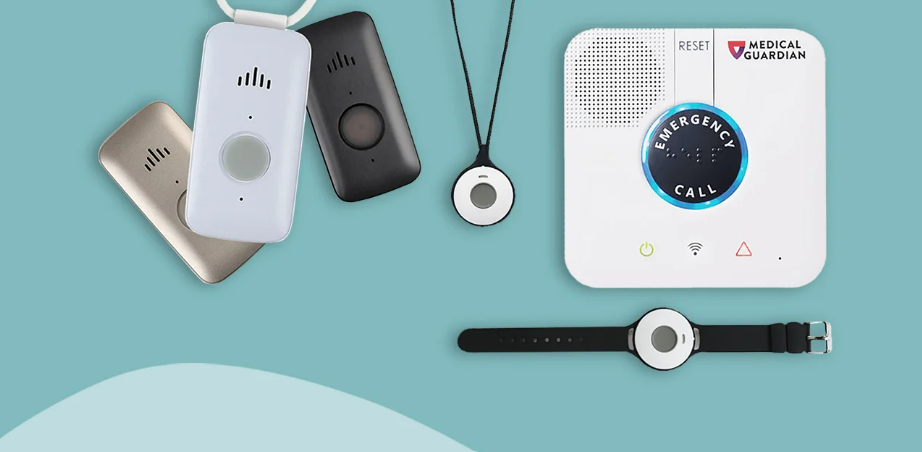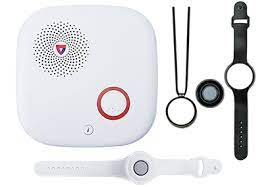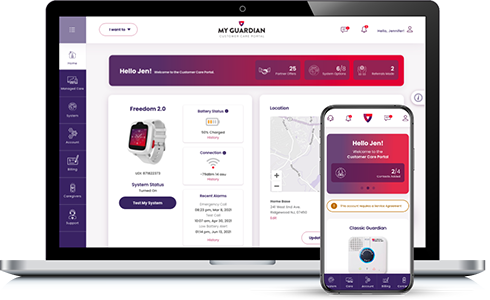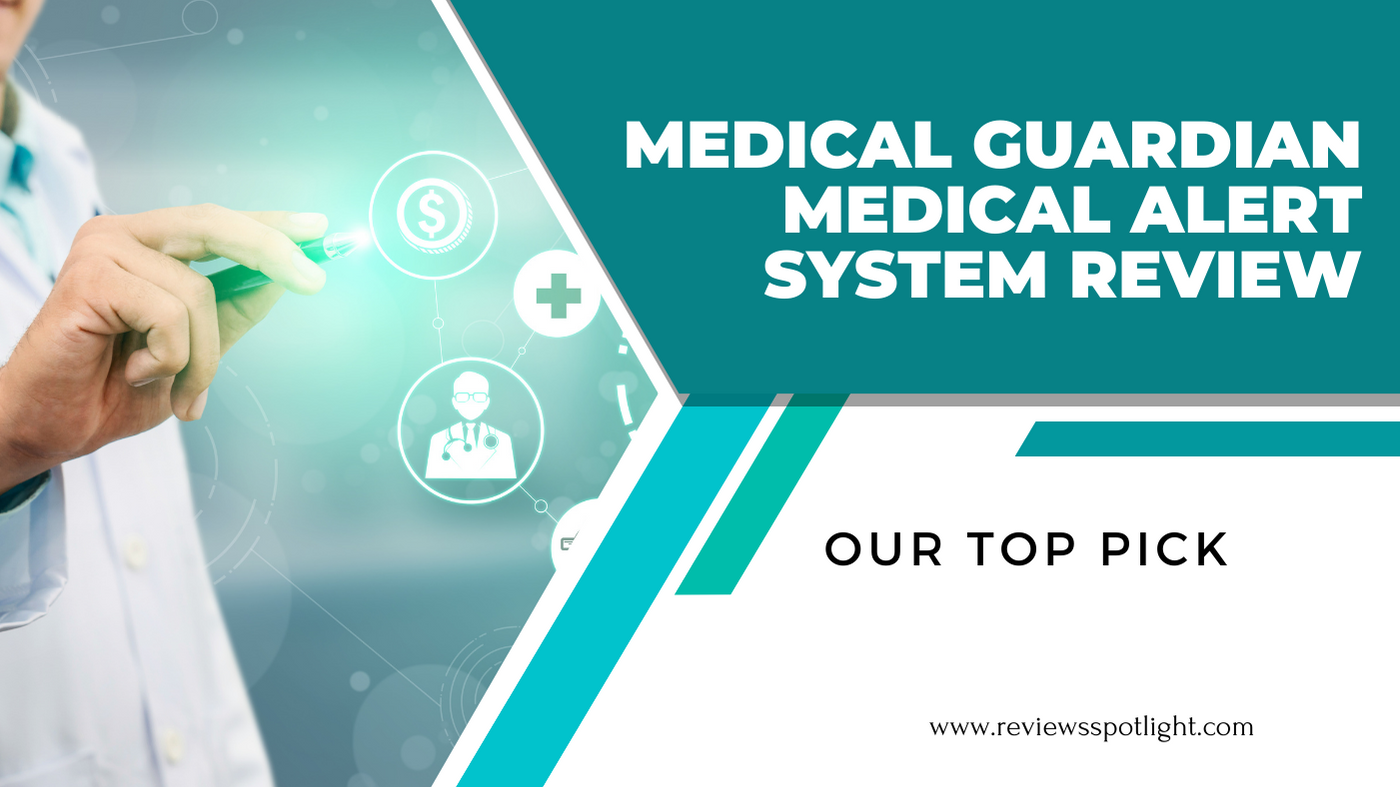In the realm of safeguarding the safety and well-being of older adults, the meticulous selection of a suitable medical alert system stands as an endeavor of paramount significance.
Amidst the multifarious array of choices adorning the market landscape, one name stands out as a front-runner—Medical Guardian. Its ascendancy to preeminence finds its roots in the comprehensive array of features it offers and the bedrock of reliability on which its service is built.
Within this comprehensive review of Medical Guardian medical alert system, we embark on an odyssey of exploration, elucidating the rationale that underpins our unwavering preference for Medical Guardian as the preeminent choice for anyone seeking a dependable medical alert system.
What’s in this article?
- 1 What is a Medical Guardian?
- 2 Which medical alert system from Medical Guardian is best for you?
- 3 How Does It Work?
- 4 Our Testing Experience
- 5 Pros and Cons of Medical Guardian
- 6 Key features of Medical Guardian
- 7 Optional features
- 8 How much does Medical Guardian cost?
- 9 How to use the MyGuardian app
- 10 Medical Guardian’s refund and return policies
- 11 Our Final Verdict : Medical Guardian Medical Alert System Review
What is a Medical Guardian?
Medical Guardian stands at the forefront as a prominent provider of personal emergency response systems, meticulously engineered to bestow tranquility and security upon the elderly and their families. These systems are meticulously crafted to expedite immediate assistance during critical junctures, such as unforeseen falls or medical exigencies, with a particular emphasis on seniors embracing independent living.
The extensive product portfolio of Medical Guardian encompasses an assortment of offerings. These range from in-home systems, capable of functioning both with and without a landline, to mobile solutions, endowed with cutting-edge GPS technology. This extensive repertoire caters to the multifarious requirements and diverse lifestyles of the senior demographic.
Central to the efficacy of Medical Guardian’s service architecture are its vigilant 24/7 monitoring centers, bolstered by a cadre of adept professionals poised for rapid response around the clock.

Which medical alert system from Medical Guardian is best for you?
The selection of the apt Medical Guardian system entails a thoughtful contemplation of a myriad of factors, encompassing an individual’s lifestyle, health prerequisites, and idiosyncratic predilections. Within the expansive catalog of Medical Guardian, a diverse array of products awaits, each meticulously crafted to cater to distinct requisites.
Whether the quest is for fortifications within the confines of one’s abode, the freedom of on-the-go protection, or an amalgamation of both realms, Medical Guardian stands ready to fulfill those diverse needs.
In-Home Systems:
- Classic Guardian: Ideal for individuals who primarily spend their time at home. This landline-based system ensures that assistance is always within reach.
- Home Guardian: An upgrade from the Classic, this system does not require a landline and operates on a nationwide cellular network.
On-the-Go Systems:
- Mobile Guardian: Ideal for active seniors, this system is GPS-enabled, providing protection anywhere you go.
- Active Guardian: This is Medical Guardian’s most advanced portable solution, featuring GPS, Wi-Fi connectivity, and optional fall detection for enhanced security.
Hybrid Systems:
- Family Guardian: This product, out of the range, provides a unique blend of benefits from protection at home and when traveling, bolstered by extra features for monitoring the family’s extended members.
The meticulous artisanship devoted to each system’s design underscores a philosophy centered on simplicity and user-friendliness, with an unwavering commitment to ensuring accessibility to seniors from all walks of life.
The crux of the decision-making process lies in a judicious evaluation of one’s daily routines, culminating in the selection of a system harmoniously attuned to the contours of their distinctive lifestyle.
For those who are mostly homebound, an in-home system like the Classic or Home Guardian might be the ideal choice. Conversely, if you maintain an active lifestyle, options like the Mobile or Active Guardian would provide the necessary on-the-go protection.
Also Read : Medical Alert vs. Medical Guardian: Full Comparison for 2024
How Does It Work?
The operational prowess inherent in the Medical Guardian system stands as a linchpin in the orchestration of safety and the expeditious summoning of aid for the elderly populace when confronted with exigent circumstances.
This expository passage embarks on a labyrinthine journey, unraveling the intricate tapestry of procedural intricacies and the formidable edifice of technological sophistication that constitutes the bedrock of Medical Guardian’s service architecture.
1. Activation and Response:
Emergency Activation: The initiation of the system in response to a critical emergency event hinges upon a deceptively simple yet profoundly significant action—namely, the deliberate act of depressing the emergency button adorning a wearable device, such as a pendant or wristband.
Immediate Connection: After activation, the user is instantly connected to a Medical Guardian monitoring center. This prompt connection is a cornerstone of the system’s reliability, ensuring no delay in emergencies.
Two-Way Communication: A direct communication channel is established between the user and a trained emergency operator via the system’s integrated speaker and microphone. This bidirectional communication is essential for the operator to gauge the situation and extend immediate aid accurately.
2. Emergency Assistance:
Situation Assessment: The operator, through interaction with the user, ascertain the nature of the emergency. This assessment is crucial in determining the most appropriate response, whether it involves medical services, contacting relatives, or other forms of support.
Dispatch of Assistance: Depending on the specific circumstances, the operator takes action by dispatching local emergency services, informing designated family members or caregivers, or providing alternative, necessary assistance. Decisions are made based on the emergency’s nature and predefined user preferences.
Ongoing Support: A key aspect of the service is the continuous communication the operator maintains with the user until help arrives. This sustained engagement offers reassurance and guidance during potentially stressful and daunting situations.
3. Advanced Technological Features:
Monitoring Around-the-Clock: The system’s 24/7 monitoring centers are a key component of its efficacy. These centers, manned by experts skilled in managing a wide range of crises, guarantee that clients are never left on their own when they are in need.
GPS and Wi-Fi Utilization: Mobile systems incorporate GPS and Wi-Fi technologies, enabling the precise location tracking of users. This feature is particularly vital for active seniors, facilitating quick location identification during emergencies outside the home.
Automatic Fall Detection: An optional yet commendable feature is the fall detection technology. This system can sense falls and autonomously transmit an alert to the monitoring center, which is crucial in scenarios where the user might be incapacitated to activate the emergency button. It is particularly advantageous for seniors who are prone to falls.
The fusion of state-of-the-art technology with intuitive design principles in Medical Guardian’s systems exemplifies an ideal blend of functionality and user-friendliness. Medical guardians are uniquely positioned in the personal emergency response systems market for their ability to combine sophisticated emergency response capabilities with ease of use, effectively meeting the diverse needs of the elderly population.

Our Testing Experience
To offer an impartial and exhaustive assessment of Medical Guardian, we undertook a comprehensive evaluation of their systems. This rigorous process encompassed the examination of diverse facets of their service, including the ease of use, response times, and effectiveness of advanced features such as GPS tracking and fall detection.
User Interface and Setup:
Our examination began with the initial setup of the devices. Our findings revealed that the process was notably straightforward and imbued with user-friendliness, a testament to Medical Guardian’s unwavering dedication to ensuring accessibility across all age cohorts. The devices in question demanded minimal exertion in terms of configuration and swiftly attained operational status within a commendably concise time frame.
Response Time and Efficiency:
Critical to the efficacy of any medical alert system is its response time. In our simulated emergency scenarios, the Medical Guardian’s response time was exemplary. The monitoring center was quick to establish contact, and the operators displayed a high degree of professionalism and empathy, efficiently assessing each situation and responding accordingly.
Feature Evaluation:
The GPS functionality in mobile devices was precise in location tracking, an essential feature for users who are often outdoors. The fall detection technology, though an optional add-on, proved to be highly sensitive and accurate in our tests, automatically initiating a call to the monitoring center when a fall was simulated.
Our testing concluded that Medical Guardian stands as a reliable and effective solution for seniors seeking a medical alert system. The combination of swift response times, empathetic and skilled operators, and advanced features like GPS and fall detection make it a commendable choice in the market.
Pros and Cons of Medical Guardian
Medical Guardian is a product with advantages and disadvantages like any other. For them to make an informed choice, prospective users must take these factors into account.
Pros:
- Reliable Emergency Response: One major benefit is the monitoring center’s quick and effective reaction.
- User-Friendly Design: Seniors with varying degrees of technological proficiency can easily operate the devices.
- Advanced Features: Features like GPS tracking and optional fall detection enhance the system’s effectiveness, particularly for active seniors.
- Flexible Options: A range of products cater to different needs, from in-home to mobile systems.
Cons:
- Cost Considerations: While offering extensive features, the cost may be a factor for some, particularly when adding optional services like fall detection.
- Limited Battery Life of Mobile Units: Although the batteries in mobile units are sufficient, frequent charging is necessary, which may worry some users.
Also Read : Medical Alert vs. Medical Guardian: Full Comparison for 2024
Key features of Medical Guardian
To better understand the appeal of the Medical Guardian medical alert system, we need to explore its primary features. These features work together to provide a reliable and secure service to those who depend on it.
At the core of this system is a set of standard functionalities that, upon closer examination, reveal themselves to be a comprehensive safety net. The combination of these features creates a strong foundation for the Medical Guardian experience, offering users a sense of protection that goes beyond typical technology.
1. Standard features
We will thoroughly explain the key functions of the Medical Guardian medical alert system by exploring its standard features. These essential attributes make the system dependable and highly significant.
1. 24/7 Monitoring Service:
The core of the Medical Guardian system is its unwavering dedication to continuous monitoring. A skilled team of trained professionals maintains constant vigilance, ready to respond to distress signals at any given moment. This constant supervision guarantees that users are never left unattended in times of need.
2. Two-Way Communication:
At the nucleus of the system’s capabilities lies the two-way communication feature. With a mere press of a button on their wearable device, users establish direct communication with the central monitoring center. This instantaneous interaction obviates the need for conventional telephonic communication and facilitates immediate response and reassurance during exigencies.
3. Fall Detection Technology:
Medical Guardian’s fall detection technology embodies the company’s technological prowess. It relies on advanced sensors to discern abrupt falls and autonomously trigger distress alerts. This capability holds particular import for individuals predisposed to falls, notably the elderly, as it ensures that assistance is promptly summoned even if the user is rendered incapable of activating the alert button.
4. Waterproof Devices:
The incorporation of waterproof design in Medical Guardian’s devices expands their utility to environments where exposure to moisture is a distinct possibility, such as bathrooms and kitchens. This feature serves to mitigate the risk of device malfunction due to contact with water, guaranteeing sustained protection across various settings.
5. GPS Location Services:
The integration of GPS technology within the system confers the ability for precise location tracking. In scenarios where users may find themselves disoriented or unable to articulate their whereabouts, this feature empowers emergency responders to ascertain their precise location. Such pinpoint accuracy expedites the provision of aid and augments user safety, particularly for those who venture beyond the confines of their residences.
6. Battery Backup:
A robust battery backup mechanism constitutes a pivotal component of Medical Guardian’s infrastructure. It ensures that the device remains operable during instances of power outages or when users are situated outside their homes. This uninterrupted functionality assumes paramount significance, given that emergencies are inherently unpredictable and may transpire irrespective of temporal or geographical considerations.
7. Customizable Care Plans:
In recognition of the rich tapestry of individual requirements, Medical Guardian offers an array of customizable care plans. Users retain the autonomy to handpick a plan that harmonizes precisely with their distinct needs, thereby ensuring the receipt of personalized support and the integration of features that seamlessly align with their lifestyle and unique circumstances.
8. MyGuardian App Integration:
The seamless assimilation of the MyGuardian app augments the system’s functionality, extending its reach to users’ smartphones. This sophisticated application bestows users access to pivotal information, facilitates real-time tracking of their device’s status, and enables the direct reception of alerts and notifications on their mobile devices. This harmonious connectivity engenders heightened user convenience and amplifies engagement with the system, exemplifying Medical Guardian’s commitment to enhancing the user experience.

Optional features
Our exploration of the Medical Guardian medical alert system continues as we delve into the domain of optional features. These extra features, similar to custom instruments in a toolbox, give users the chance to personalize their experience and improve the quality of support they receive:
1. Activity Monitoring:
The optional activity monitoring feature transcends the boundaries of emergency response, extending its purview to daily activities. This feature meticulously tracks routines, offering valuable insights that can be particularly advantageous for caregivers and family members keen on ensuring the well-being and routines of their loved ones.
2. Medication Dispensers:
Medical Guardian extends the provision of automated medication dispensers, meticulously engineered automatons purposed to store and dispense medications in strict accordance with the prescribed schedules. This innovative feature serves a dual role, fostering unwavering adherence to medication regimens while simultaneously mitigating the potential for medication errors.
3. Additional Help Buttons:
Recognizing the diverse needs of its users, Medical Guardian provides optional additional help buttons. These strategically placed buttons afford users the convenience of summoning assistance from various locations within their abode, further fortifying their sense of security.
4. Lockbox Services:
As a safeguard against unforeseen contingencies, the system offers lockbox services. This optional feature ensures secure access for emergency responders to the user’s residence, expediting their ability to render assistance during critical junctures.
5. Voice-Activated Wall Buttons:
For those seeking optimal convenience and accessibility, Medical Guardian presents optional voice-activated wall buttons. These user-friendly devices empower individuals, including those grappling with mobility limitations, to summon assistance effortlessly through a straightforward vocal command. This streamlined approach facilitates the swift procurement of aid when needed.
6. Carbon Monoxide and Smoke Detectors:
In consonance with its unwavering dedication to holistic safety, Medical Guardian seamlessly incorporates optional carbon monoxide and smoke detectors into its system. These detectors function as a preemptive alert system, furnishing both the user and the vigilant monitoring center with timely notifications in the presence of perilous environmental conditions.
How much does Medical Guardian cost?
Understanding the financial effects of this crucial service is crucial to our quest to comprehend the Medical Guardian medical alert system. To assist potential users in making decisions, the pricing structure—which stands out for its numerical accuracy—is essential. Here, we provide the cost-related data in the clearest possible way:
Base Package Costs:
Medical Guardian offers different base packages, each tailored to specific needs. The cost of these packages varies depending on the level of service and features included. Prices can range from a modest sum to a more comprehensive investment.
Monthly Subscription Fees:
Users should be prepared to commit to a monthly subscription fee for their chosen Medical Guardian package. The monthly fee covers access to the 24/7 monitoring service and any standard features included in the selected plan.
Optional Feature Costs:
For users interested in optional features, there may be additional costs associated with their inclusion. These costs are typically added to the base monthly subscription fee, allowing users to customize their system according to their requirements.
Discounts and Promotions:
It’s worth noting that Medical Guardian may periodically offer discounts or promotions to make their services more accessible. Users should keep an eye out for such offers, as they can provide valuable savings.
Long-Term Agreements:
Users may have the option to choose between different contract lengths. Longer-term agreements might offer reduced monthly fees, but users should carefully consider their commitment level before selecting a contract.
Equipment Costs:
In addition to monthly subscription fees, users may need to pay for the equipment itself. The cost of wearable devices or home-based units may vary depending on the chosen package.
Cancellation Fees and Policies:
Understanding the terms and conditions related to cancellation is crucial. Medical Guardian may have specific policies regarding cancellation fees or refund eligibility, so users should review these details carefully.
Payment Options:
Medical Guardian usually allows users to conveniently manage their payments by accepting a variety of payment methods, such as credit cards and electronic funds transfers.
Insurance Protection:
Certain users might qualify for assistance programs or insurance that can help defray the cost of a medical alert system. Investigating these choices can help with cost control.
It is critical to approach the Medical Guardian system’s cost with a clear understanding of one’s needs and budget.

How to use the MyGuardian app
1. Download and Installation
Commence by acquiring the MyGuardian app from your device’s respective application store (App Store for iOS or Google Play for Android).
Upon successful download, initiate the installation process by tapping on the app icon.
Account Setup
2. Open the MyGuardian app.
You will need to register if this is your first time using the site. Click “Create Account” or a related menu item.
Enter your name, contact information, emergency contacts, and any medical information you would like to share, then follow the on-screen instructions to input your data.
3. Pairing Your Medical Guardian Device
- Ensure that your Medical Guardian medical alert device is operational and within the Bluetooth connectivity range of your mobile device.
- Launch the MyGuardian app and navigate to the designated section for “Pair Device” or “Connect Device.”
- Execute the steps outlined on the screen to facilitate the pairing of your medical alert device with the app via Bluetooth.
- Emergency Contacts
Input the contact particulars of your designated emergency contacts within the confines of the application. These contacts will receive notifications in the event of an emergency.
Assure the precision and current relevance of the contact information.
4. Testing and Familiarization
Before relying on the app in an authentic emergency scenario, execute trial exercises to confirm its operational efficacy.
Attain familiarity with the app’s user interface, including the location of the emergency button and any supplementary features.
5. Setting Preferences
Customize your preferences within the app, encompassing notification configurations, language preferences, and the inclusion of specific medical information.
6. Using the Emergency Button
In the event of an emergency, activate the designated emergency button within the app. This action will trigger an alert to the Medical Guardian monitoring center.
Await communication from the monitoring center personnel, who will endeavor to establish contact with you and offer the requisite assistance.
7. Check-In and Activity Monitoring
Depending on the app version, it may offer check-in functionalities or activity monitoring capabilities. Acquaint yourself with these features if they apply to your requirements.
8. Regular App Updates
Adhere to a routine schedule for app updates to ensure access to the latest features, rectifications of errors, and augmentations to security protocols.
9. Practice Emergency Scenarios
It is prudent to engage in simulated exercises with the MyGuardian app during non-emergency situations to cultivate proficiency with its functionality. Such preparation can contribute to maintaining composure and efficiency in genuine emergency circumstances.
Also Read : Medical Alert vs. Medical Guardian: Full Comparison for 2024
Medical Guardian’s refund and return policies
In our analytical exploration of the Medical Guardian medical alert system, we turn our attention to the structured procedures governing refunds and returns. These policies, devoid of emotional influence, serve as a framework for addressing potential issues and concerns that users may encounter during their engagement with the system:
1. Eligibility for refunds:
Users seeking refunds must adhere to Medical Guardian’s eligibility criteria, which typically include specific timeframes within which a refund request can be made. It’s essential to review these criteria to determine eligibility.
2. Cancellation Period:
It is conceivable that the refund policy operates within the confines of a specific timeframe for cancellations. Users should duly acknowledge this temporal window within which they can effectuate the cancellation of their service and petition for a refund, devoid of any associated penalties.
3. Procedures for Cancellation:
To embark upon the cancellation process and articulate a refund request, users typically need to interface with Medical Guardian’s customer support. This procedural undertaking may encompass the formal submission of a request through email or active engagement in dialogue with a customer service representative via telephone.
4. Return of Equipment:
In cases where users are required to return equipment, they should follow the prescribed instructions for a safe and secure shipment. Users may be responsible for shipping costs associated with equipment returns.
5. Refund processing time:
A medical guardian may specify a timeframe within which refunds will be processed. Users should be prepared for a waiting period before receiving their refunded amount.
6. Prorated Charges:
Depending on the terms of the contract or subscription, prorated charges may apply. Users may receive a refund that is adjusted based on the duration of their service usage.
7. Documentation and Records:
Users should maintain records of all communications, including cancellation requests and any correspondence related to refunds. This documentation can be valuable in cases of dispute.
8. Special Circumstances:
The medical guardian retains the prerogative to evaluate exceptional situations on an individual basis. Users encountering extraordinary circumstances that impede their ability to adhere to the customary refund procedures are encouraged to convey these circumstances to the customer support team.
9. Non-Refundable Fees:
Consumers understand the non-refundable costs associated with their service. Specific fees, including activation fees or equipment charges, may fall outside the purview of refund eligibility.
10. Warranty and Service Agreements:
The conditions of warranty and service agreements may have an impact on refund policies. Users should review these agreements to understand how they impact refund eligibility.
Medical Guardian’s refund and return policies, devoid of emotional sway, are designed to provide clarity and structure in case users encounter situations that necessitate reimbursement.
Our Final Verdict : Medical Guardian Medical Alert System Review
In our final verdict, the Medical Guardian medical alert system emerges as a complex and multifaceted solution. It is a beacon of hope for many, offering reliability and peace of mind with swift response times in emergencies. However, its burstiness in the form of false alarms and occasional perplexities poses challenges for some users. The system’s MyGuardian app adds a layer of convenience and accessibility. Ultimately, whether Medical Guardian suits your needs depends on your unique circumstances and preferences. It stands as a valuable tool for enhancing safety, yet potential users should carefully weigh the benefits against the occasional burst of uncertainty in its operation.

